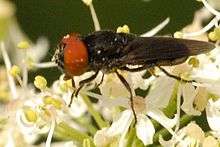Chrysogaster solstitialis
Chrysogaster solstitialis is a European species of hoverfly.[1]
| Chrysogaster solstitialis | |
|---|---|
 | |
| male | |
 | |
| female | |
| Scientific classification | |
| Kingdom: | |
| Phylum: | |
| Class: | |
| Order: | |
| Family: | |
| Genus: | |
| Species: | C. solstitialis |
| Binomial name | |
| Chrysogaster solstitialis (Fallén, 1817) | |
| Synonyms | |
Description
External images For terms see Morphology of Diptera
Wing length 6-7·25 mm. Antennae reddish. In front view the distance between the eyes at most equal to the width of an eye. Wings blackish-tinged. Female thorax with purplish reflections. The male genitalia are figured by Maibach, A. & Goeldlin de Tiefenau (1994).[2] [3] [4] [5][6] The larva is illustrated by Rotheray (1993).[7]
Distribution
Palaearctic. Ranges from Fennoscandia South to Iberia and the Mediterranean basin, including North Africa. From Ireland Eastwards through of Europe into European parts of Russia, Ukraine and the Caucasus mountains.[8][9]
Biology
Habitat:Wetland and deciduous forest, woodland streams and ponds including Salix carr. Flowers visited include white umbellifers, Cornus, Filipendula, Galium, Sambucus, Senecio jacobaea. The flight period is June to September ( May in southern Europe). The larvae live in pond mud containing debris of fallen twigs and branches.[10] [11]
References
- Stubbs, Alan E.; Falk, Steven J. (1983). British Hoverflies: An Illustrated Identification Guide (2nd (revised) ed.). British Entomological & Natural History Society. p. 253, xvpp. ISBN 0-9502891-3-2.
- Maibach, A. & Goeldlin de Tiefenau, P. (1994) Limites génériques et caractéristiques taxonomiques de plusieurs genres de la Tribu des Chrysogasterini (Diptera: Syrphidae) III. Descriptions des stades immatures de plusieurs espèces ouest-paléarctiques. Rev.suisse Zool., 101: 369-411.
- Van Veen, M. (2004) Hoverflies of Northwest Europe: identification keys to the Syrphidae. 256pp. KNNV Publishing, Utrecht.addendum
- Van der Goot,V.S. (1981) De zweefvliegen van Noordwest - Europa en Europees Rusland, in het bijzonder van de Benelux. KNNV, Uitgave no.32: 275pp. Amsterdam.
- Bei-Bienko, G.Y. & Steyskal, G.C. (1988) Keys to the Insects of the European Part of the USSR, Volume V: Diptera and Siphonaptera, Part I. Amerind Publishing Co., New Delhi. ISBN 81-205-0080-6.
- Coe, R.L. (1953) Diptera: Syrphidae. Handbks.ident.Br.insects, 10(1): 1-98. R.ent.Soc.London. pdf
- Rotheray G., 1993 Colour Guide to Hoverfly Larvae Diptera, Syrphidae in Britain and Europe Dipterists Forum pdf Archived 2019-04-03 at the Wayback Machine
- Fauna Europaea
- Peck, L.V. (1988) Syrphidae. In: Soos, A. & Papp, L. (eds.) Catalogue of Palaearctic Diptera, 8: 11-230. Akad.Kiado, Budapest.
- de Buck, N. (1990) Bloembezoek en bestuivingsecologie van Zweefvliegen (Diptera, Syrphidae) in het bijzonder voor België. Doc.Trav. IRSNB, no.60, 1-167.
- Speight, M.C.D. (2011). "Species accounts of European Syrphidae (Diptera)" (PDF). Syrph the Net, the database of European Syrphidae. 65: 285pp.